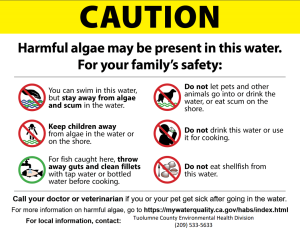Sonora, CA – Caution signs warning of potentially harmful algae in river waters above New Melones are up as test results show the presence of cyanobacteria.
Last Friday, as reported here, the State Water Resources Control Board issued a warning about a potential harmful algal bloom (HAB) in the Middle Fork of the Stanislaus River upstream of the New Melones reservoir.
This afternoon, lab results on the three water samples found the presence of the cyanobacteria Dolichospermum dominant in the bloom. Another cyanobacteria Aphanizomenon was also noted by Water Board staff in two shoreline collection samples subdominant in the bloom. Although the results did not detect toxins in the blooms, a caution advisory is still being recommended until the bloom subsides.
According to Dr. Keith Bouma-Gregson, an environmental scientist at the Water Board who took part in the sampling, blooms often peak in the summertime. “We are kind of in prime cyanobacteria bloom season right now, “ he shares. As blooms might last for a few weeks at a time in different places, some of them year-round, he confides that it becomes a cat and mouse game for those monitoring for HABs.
Asked about the greener than normal appearance of the waters at New Melones, which is not under a caution advisory, Bouma-Gregson acknowledges it is algal growth that probably includes cyanobacteria. “We will keep observing bloom conditions to see if it gets greener or denser and starts to produce toxins or not,” he states.
Earlier today, Tuolumne County Public Health spokesperson Michelle Jachetta shared that the caution signs were posted from the Tuttletown boat ramp all along the river to Camp Nine and the log jam. She also indicated that water samples taken July 24 were drawn at the Parrotts Ferry Bridge, the confluence with Rose Creek, and up at the river log-jam.
What To Know, Do, Avoid
The posted signs advise recreaters that they can swim in the water but should stay away from algae and scum in it and that children should keep away from algae in the water or on the shore. The postings specifically say DO NOT let pets and other animals do into or drink the water or eat scum on the shore; do not drink the water or use it for cooking; do not eat shellfish from the water; and for fish caught in the area, throw away the guts and clean fillets with tap or bottled water before cooking. Additionally, the signs instruct folks to call their doctor or veterinarian if they or their pets get sick after going in the water.
Evident in almost all aquatic ecosystems, Bouma-Gregson points out. “Cyanobacteria has been around for billions of years on this Earth. They are very old organisms. However most of the time they exist in very low abundance so they are not in, say a bloom state.”
He continues, “When certain environmental conditions allow…it can start to grow very quickly, resulting in a bloom that can take over a water body.” However, he emphasizes that not all of them are producing toxins. “So, when we see a bloom, we have to go out and do additional testing to understand if they are producing some of the toxins that might be harmful to humans, pets and livestock.”
People or animals can be directly exposed to cyanotoxins in freshwater during recreational activities or by breathing in toxins in the water that become tiny airborne droplets or mist. Those exposed to the toxins through direct skin contact or inhalation may experience irritation of the skin, eyes, nose, throat or respiratory system. Depending on the specific chemical structure of cyanotoxins, they can be neurotoxins that affect the nervous system, hepatotoxins that affect the liver, dermatoxins that affect the skin, or other toxins that affect the stomach or intestines.
He stresses the importance for recreaters to practice healthy water habits when they are out on the waters. The guidelines for these are specifically outlined in the abovementioned caution signs. Also, report any suspected HAB or potential HAB-related illness.

